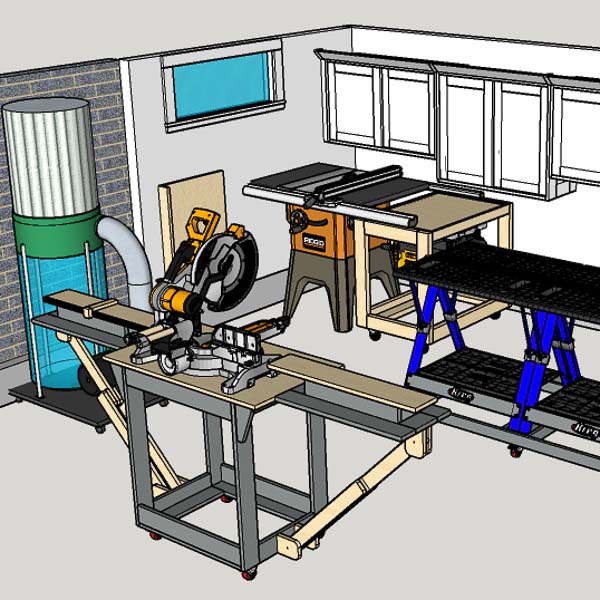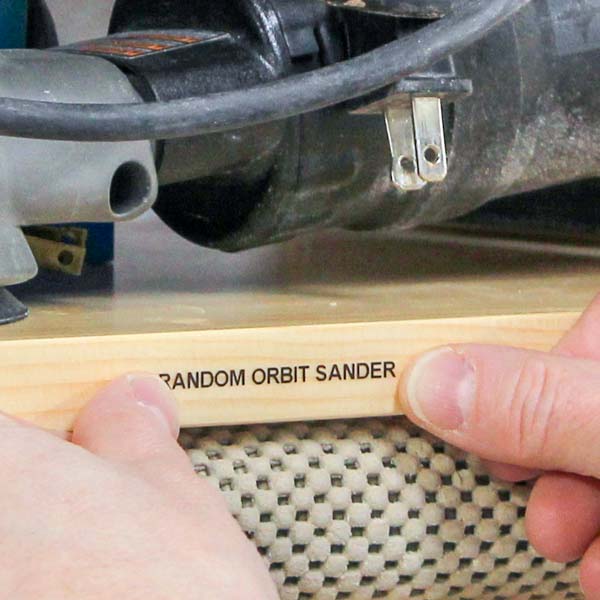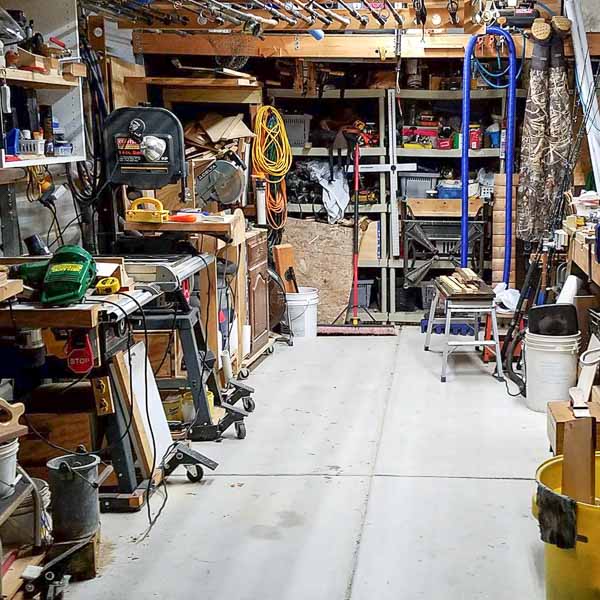9 Ways to Get Into Woodworking Without a Garage
Interested in woodworking but don’t have a garage? You don’t need one! Here are 9 ways to get into the hobby and start building now.
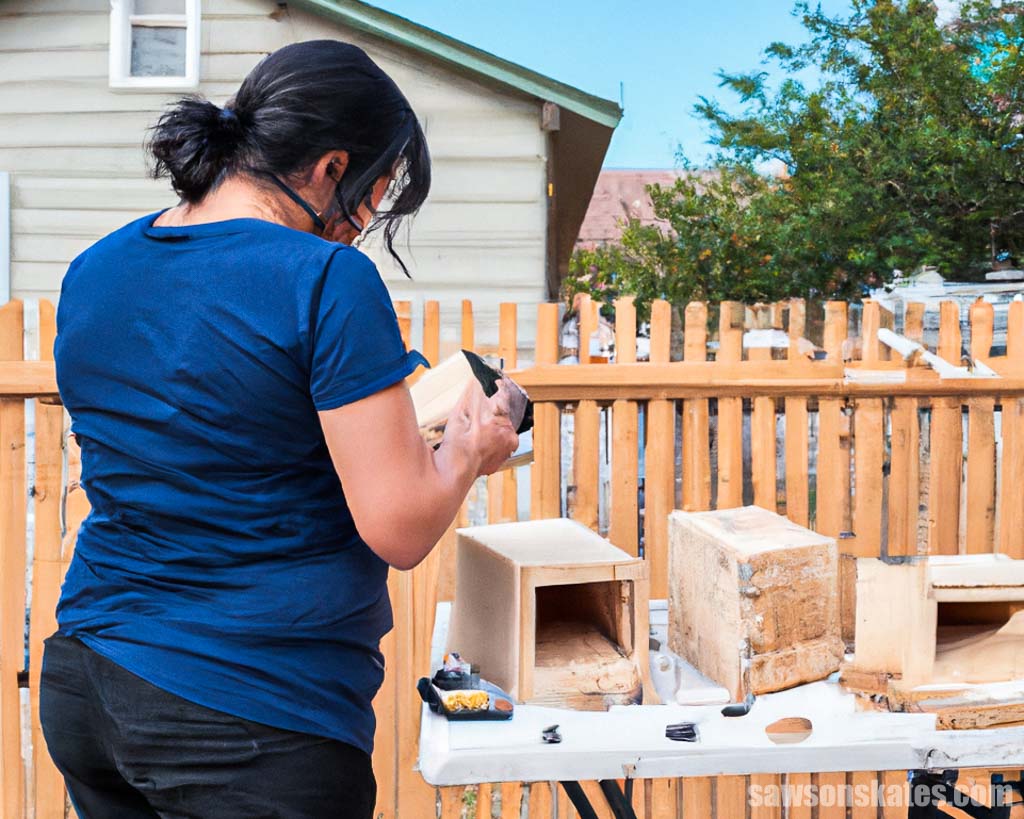
If you want to get into woodworking but don’t have a garage, don’t worry! There are plenty of places where you can set up shop and start creating beautiful pieces. In this article, we’re sharing nine of our favorite ways to get into woodworking without a garage.
So whether you live in an apartment or don’t have the space for a workshop, these garage alternatives will help you get started on your next project.
Originally published September 26, 2017, updated October 21, 2022.
This tutorial contains affiliate links to supplies and tools. Purchases made using these links help support the Saws on Skates website and allows me to share more projects and tips with you. There is no cost to you for using these links. Visit my site policies for more information.
1. Basement Workshop
If you have one, a basement is an excellent place to set up your woodworking shop.
What are the Advantages of a Basement Workshop?
There are a few advantages to a basement workshop.
First, basements are generally unfinished, so there’s no stress about damaging your floors or walls.
Second, basements are generally a comfortable temperature to work in year-round.
And finally, basements muffle the noise from your tools, so you don’t have to be concerned about disturbing your neighbors.
However, there are a few things to keep in mind if you’re considering using your basement as a woodworking shop.
What are the Drawbacks of a Basement Workshop?
Getting materials into your basement shop can be challenging if you don’t have an exterior entrance, and it can be especially tricky when working with sheet goods such as plywood or MDF. You’ll likely need to break down those materials into smaller pieces outside before bringing them downstairs.
Related: 9 Clever Ways to Make Your Small Workshop Feel Bigger
Without an outdoor entrance, you might be limited to doing smaller projects or need to build larger ones in sections that you can assemble outside of your shop.
Many basement ceilings are low, so standing or maneuvering material might be difficult. Also, most basements have concrete floors, which can cause fatigue if you’re standing for long periods.
To combat this, consider investing in anti-fatigue mats, a good pair of shoes, or both. I’ve purchased numerous pairs of these sneakers that are popular among nurses, who often need to stand for prolonged periods.
Sawdust goes everywhere, so you’ll want to be mindful if your shop will share space with other areas in your basement, such as a furnace, laundry room, or storage area. Even with a dust collection system, a layer of sawdust will quickly build up on anything you have in your basement, such as clothes, canned goods, or exercise equipment.
Related: My Small Shop Dust Collection System
Basements are often dark, with only a few small windows, which can make lighting and ventilating your workspace a challenge. You’ll want to make sure you have plenty of lighting so you can see what you’re doing, so consider installing some overhead lights to brighten up the space. I have a handful of LED shop lights in my shop, and they work great.
Related: My 12×13 Small Woodshop Layout
You’ll want to avoid using flammable liquids in your basement shop, such as oil-based solvents and top coats if it’s not well-ventilated or shares space with a heat source such as a gas or oil-fired furnace or water heater.
Also, basements can be damp, so you’ll want to ensure your tools and materials are stored off the floor and away from any potential water damage.
Depending on how your basement is laid out, you may need to consider soundproofing to prevent disturbing your family members.
Despite these potential challenges, a basement workshop can be a great space for woodworking if you take the time to plan it out and set it up properly.
2. Shed Workshop
If you’re looking for a dedicated woodworking space but don’t have a garage, consider using your shed or adding one to your backyard. You can turn your shed into the perfect workshop with some planning and minimal effort.
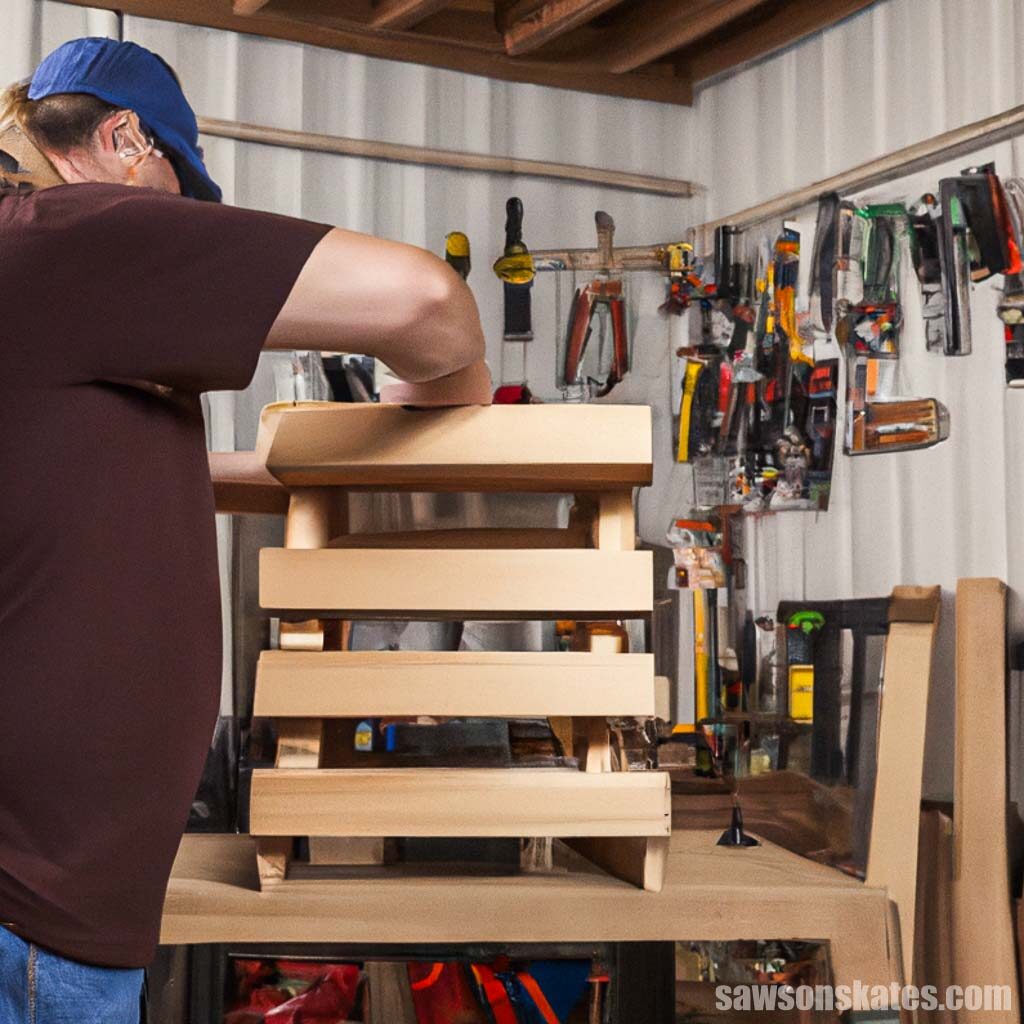
What are the Advantages of a Shed Workshop?
One of the primary benefits of a shed workshop over a basement shop is that it cuts down on the amount of sawdust in your home.
Many sheds are unfinished, making it easy to add windows or alter door openings to fit your needs.
If you don’t have a shed, you can order one built to your specifications and delivered to your backyard. Or, if you’re feeling adventurous, build the shed yourself and pick up some new skills in the process.
💡 TIP: Always consult your local building department to see if there are any restrictions or permits needed before you build or use a shed workshop.
When shopping for a shed, look for one with a wide door or double doors so it will be easy to move materials, tools, and projects in and out of your shop.
What are the Drawbacks of a Shed Workshop?
Keep in mind that sheds are not usually temperature controlled, so it might be too hot to work in the summer and too cold to work in the winter. Also, power may not be available in your shed, so you may need to hire an electrician to wire your shop.
Depending on your shed’s location and where you can park, you might have to carry materials a long distance, which can be cumbersome.
Also, if you live in an HOA community or have nosy neighbors, they may not appreciate the noise created by your tools, and could give you some trouble.
Overall, a shed can become an excellent woodworking shop with a bit of planning, time, and effort.
3. Woodworking in an Apartment
If you live in an apartment, you might think that woodworking is out of the question, but there are still plenty of ways to get into this hobby.
What are the Advantages of an Apartment Workshop?
If your apartment has a balcony or deck, then you already have a great spot for setting up a woodworking shop. Just be sure to check with your landlord or HOA first to make sure it’s OK to use these spaces for woodworking.
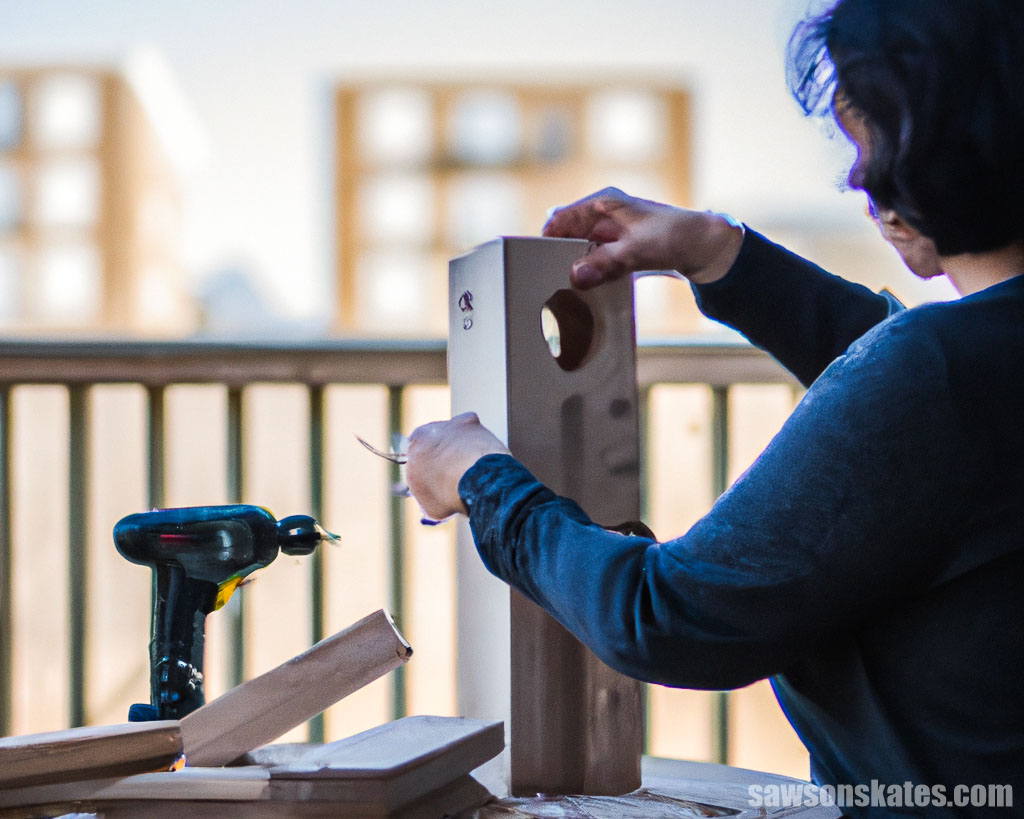
You can use store-bought folding tables or make a folding workbench to create a space-saving workstation. If you’re concerned about making too much noise, consider using hand tools or small power tools like a drill. These are much quieter than their electric-powered counterparts and can still get the job done.
Related: How to Make a DIY Folding Workbench
On a recent trip to visit my friend in his small California apartment, we built a project on his balcony: a “potty patch” for his dog. We cut cedar boards with a miter box and handsaw, then used a hammer and nails to wrap an automotive oil change tray with the wood.
The finishing touch was adding a section of sod to the tray. This created a great space for his pup to relieve himself in between walks around town.
On another trip, we renovated a small craigslist sideboard into a kitchen island. Again, we cut some boards using the miter box and handsaw to make a box and screwed it to the top of the sideboard.
Next, we added some corbels similar to these DIY shelf brackets to the back of the sideboard. The box and corbels supported a wood IKEA countertop. Lastly, we painted the sideboard black. It turned out great, and we did all of the work on his balcony.
Another advantage of an apartment workshop is that you can easily pack it up and move it to another location.
What are the Drawbacks of an Apartment Workshop?
The biggest drawbacks of an apartment shop are noise, working in a confined space, and storing your tools.
If your workshop is on a balcony, be aware that your neighbors might not appreciate the noise level created by your tools. You’ll want to take measures to reduce the amount of noise you’re making, such as using hand tools instead of power tools and avoiding working early in the morning or late into the evening.
Working in a confined space is another big issue. You won’t have a lot of room to move around or maneuver material, so you’ll need to be efficient with how you use your space. Be sure to unplug tools when not in use and put them away, so they don’t create tripping hazards.
Storing your tools in an apartment can be a challenge. If you don’t have a storage closet, consider using under-bed storage containers to keep your tools out of the way but still easily accessible.
Overall, woodworking in an apartment is possible, but it does have its challenges. Be prepared for noise, lack of space, and finding creative ways to store your tools and materials.
4. Outdoor Workshop
If you have a driveway or yard, you can easily set up an outdoor workshop. Working outside obviously comes with some weather-related challenges, but if you’re prepared for those, an outdoor shop can be a great option.
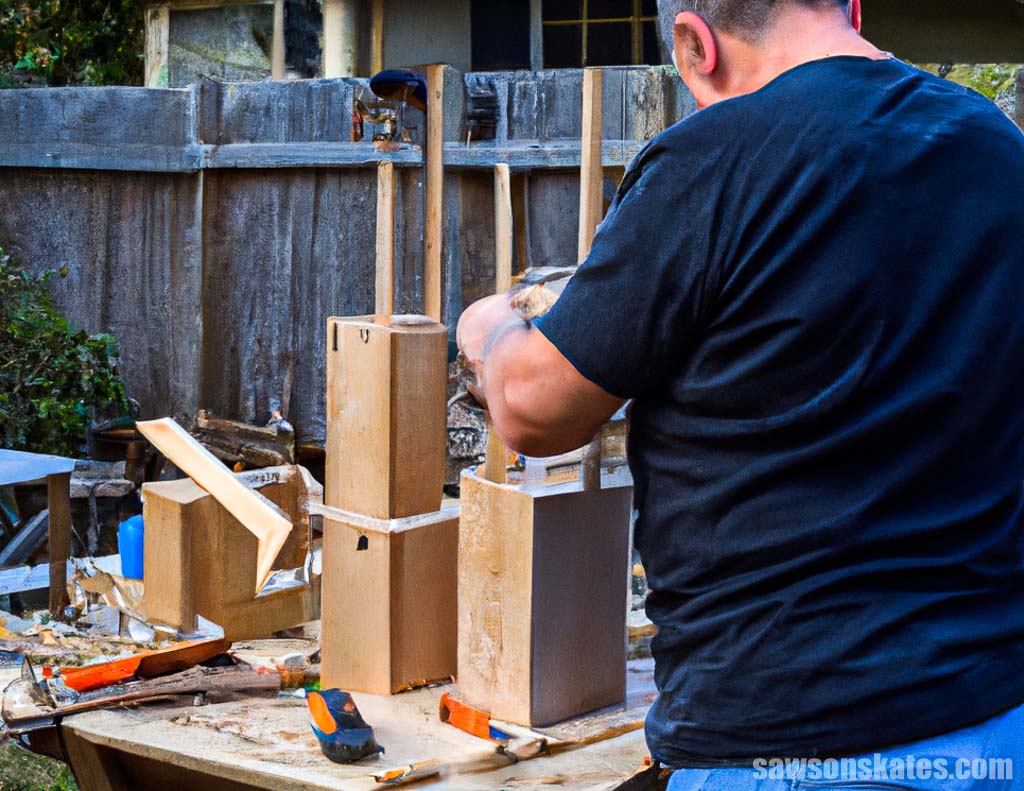
What are the Advantages of an Outdoor Workshop?
One of the things I enjoy the most about working in my driveway is the sawdust is outside and not in my shop. You can easily clean up your workspace at the end of the day by sweeping the sawdust or blowing it into the grass with a leaf blower.
Working outdoors is a great way to build large projects because you’re not limited by the size of an indoor workspace. The majority of my DIY truck camper was built in my driveway.
What are the Drawbacks of an Outdoor Workshop?
There are some drawbacks to working outside that you should consider before setting up a shop in your yard or driveway.
For starters, setting up and tearing down your gear over and over can get old quickly.
Additionally, the weather can be a challenge when working outdoors. If you live in an area with extreme temperatures, you may not be able to work outside year-round.
Even if you wear safety glasses, sawdust can still blow into your eyes and trust me, that is not fun. Wind can also make it difficult to apply finishes like paint and polyurethane by blowing dust and debris into your uncured project.
Related: Polyurethane vs Polycrylic: Are They The Same?
If you have to apply finishes outdoors, I recommend using one of these spray shelters. They’re easy to set up and take down and will protect your project from damage.
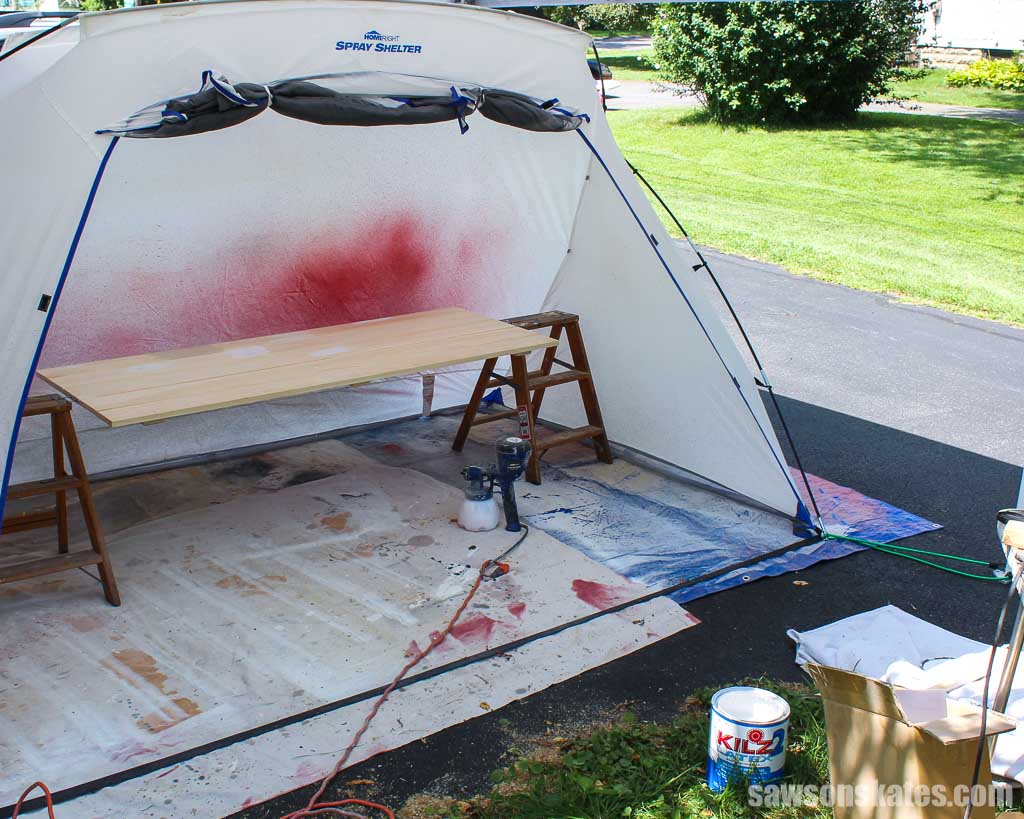
Rain can put a damper on your projects, and working in the sun can be hot and exhausting. For those reasons, I recommend using an E-Z UP to keep your work area relatively dry and out of direct sunlight.
The noise from your power tools can disturb your neighbors, so be considerate and try to work during daylight hours. You might even consider giving them one of your handmade creations to show your appreciation for their understanding.
Finally, if you have small children or pets, you’ll need to take extra precautions to keep them safe while you’re working.
There are some challenges to working outside, but if you’re prepared for them, it can be a great option for setting up a woodworking shop.
5. Makerspace or Community Workshop
If you don’t have the space for a workshop at your home, consider joining a community workshop.
A community workshop or makerspace is a shared space where people have access to tools and equipment, so it’s a great option if you’re just getting started with woodworking. These spaces are usually membership-based and have either hourly or monthly rates.
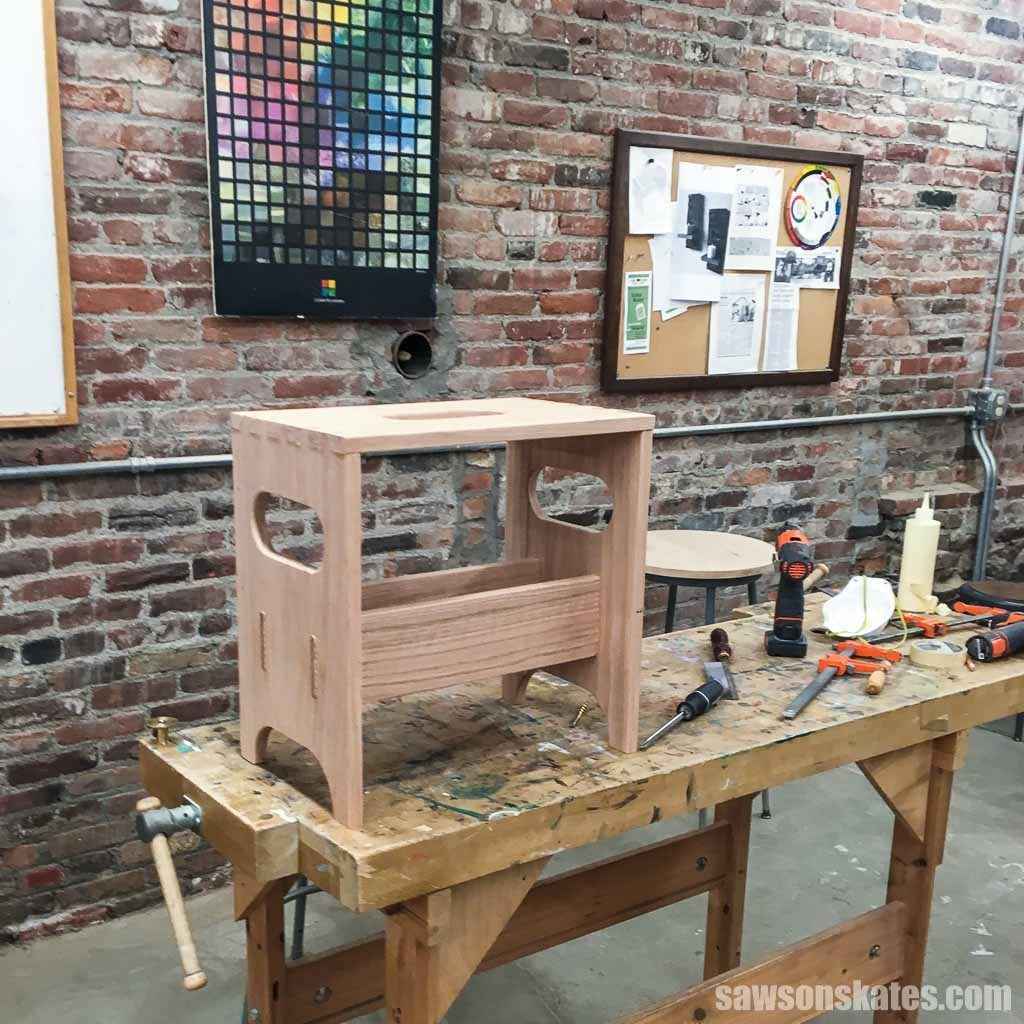
What are the Advantages of Community Workshops?
The great thing about community workshops is that they provide a place to work on projects, and they usually have an area to store your project, so you don’t have to haul it back and forth between visits.
Community workshops are a great place to meet other woodworkers and learn new skills. Most makerspaces have knowledgeable staff members who can provide guidance with your projects and answer any questions you may have. Many also offer classes to help you learn new woodworking techniques.
What are the Drawbacks of a Community Workshop?
Of course, there are some drawbacks to using a community workshop. The most obvious one is the cost. While the membership fees are usually reasonable, they can add up over time.
Another potential downside is not every community has a makerspace, so you may have to travel some distance to get to one. If the distance is too far, it might not be worth the effort. Also, you may have to schedule your time around the workshop’s hours of operation.
Additionally, when the community workshop is busy, you may have to wait to use the tools you need or get help from staff members.
If you’re looking for a place to work on your woodworking projects, a makerspace is a great option.
6. Woodworking Classes
If you want to get into woodworking but don’t have the space for a shop, consider taking some classes.
Classes are frequently offered at art centers, woodworking stores, makerspaces, woodworking clubs, and many high schools and colleges offer continuing education classes in woodworking.
Related: 11 Places to Take Beginner Woodworking Classes
Most woodworking classes meet once a week for several weeks, so they can easily fit into your schedule. They usually have a set project you’ll complete throughout the course, so you’ll learn new skills and take home a finished project at the end.
What are the Advantages of Woodworking Classes?
Taking a class is a great way to learn new skills and techniques. You’ll have access to all the tools and equipment you need, and you’ll be able to ask questions and get help from the instructor.
Most woodworking classes are taught by experienced woodworkers who can show you how to use the tools safely and effectively. You’ll also get the opportunity to meet other people interested in woodworking, which can be a great motivator to keep practicing your skills.
What are the Drawbacks of Woodworking Classes?
Some of the disadvantages of taking woodworking classes are the cost and time commitment.
Classes can be expensive depending on the length and the cost of the materials required for the project.
You’ll also have to schedule your time around the class and commit several weeks to complete a project.
However, classes can be an excellent investment if you’re serious about getting into woodworking.
7. Woodworking Clubs
Another great way to get into woodworking, meet other like-minded people and learn new skills is to join a woodworking club.
My local woodworking club offers monthly newsletters and meetings, an annual woodworking show, and an annual wood and tool auction. Additionally, some woodworking clubs have open shop time where you can use their tools and shop space to build your projects.
A quick Google search of “woodworking clubs near me” should give you a few results.
What are the Advantages of Joining a Woodworking Club?
Joining a woodworking club has many of the same advantages as using a community workshop. You’ll have access to tools and equipment, knowledgeable people to help you with your projects, and classes to improve your skills.
Most clubs have an annual membership fee, while some may charge monthly or quarterly dues, but these fees are relatively small compared to the cost of setting up and maintaining your own shop. For example, my local woodworking club has an annual membership fee of only $60.
What are the Drawbacks of Joining a Woodworking Club?
Just like a makerspace, one of the drawbacks is not every community has a woodworking club. So, you may have to do some traveling to get to one.
Some clubs may not have open shop hours, or you might only be able to use the space when they’re hosting a class or an event. Before joining, check out their website or give them a call to find out the requirements and restrictions for using their workshop.
Overall, joining a woodworking club is a great way to get started with woodworking. You’ll have access to tools and knowledgeable people to help you with your projects.
8. Friends and Family
If you have a friend or family member who is already into woodworking, they might allow you to use their workshop. Or if they’re not into woodworking, but they have an unused space, such as a garage, shed, or carport, they might be willing to let you use it as a shop.
A few things to remember when working in your friend’s or family member’s shop: if you want to be invited back, take better care of their tools than you would your own; and when finished for the day, leave the workshop cleaner than it was when you arrived.
The same goes if they allow you to set up a shop at their home. Keep the area neat, pick up any messes before leaving, and be considerate of their living space.
9. Rent a Space
If you don’t have any extra space around your home for a woodworking shop and your budget allows, consider renting a garage. Garage rentals on Craigslist in my area typically range from $150 to $175. Although renting a space can be expensive, it might be worth it if you plan on woodworking frequently or turning your hobby into a side hustle.
Before signing a lease, be sure to ask the owner if it’s OK to build in the garage. Make sure the garage has power outlets and that you’re allowed to use the electricity. Also, be sure the garage is close to your home. If the garage is too far from your home, the chances increase that you won’t go there to build.
What to Avoid: a Spare Room
I’ve seen some people suggest using a spare room in your home as a woodworking shop. I don’t recommend using a spare room as a shop for one reason: sawdust.
No matter how well you try to contain it, the sawdust will float to other areas of your home. Even with a dust collection system, you’ll likely find a layer of dust on your clothes, furniture, and in your carpet.
Another potential problem with using a spare room as your shop is the noise level. Woodworking tools can be quite loud, so if you have thin walls or close neighbors, they may not appreciate the sound of your tools.
Overall, I don’t recommend using a spare room as a woodworking shop. If you have your mind set on it, be sure to use plenty of plastic sheeting to contain the sawdust, and consider soundproofing the walls to protect your family and neighbors from the noise.
Final Thoughts
Woodworking is a rewarding pastime, but it can be difficult to get started without a garage. Hopefully, this article has given you some ideas on how to get into this hobby.
Whichever route you choose, remember it’s important to have fun and enjoy the process. Don’t get too caught up on having the perfect shop; it’s more important to focus on building your skills. With time and practice, you’ll eventually have a shop that meets your needs. And in the meantime, you’ll be able to create some amazing projects.
Thank you for stopping by. If you enjoyed this tutorial, would you please take a moment and pin it to Pinterest? I’d really appreciate it!

